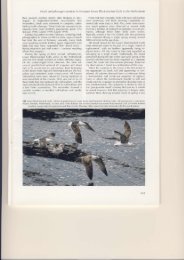Identification of American Herring Gull in a western European context
Identification of American Herring Gull in a western European context
Identification of American Herring Gull in a western European context
You also want an ePaper? Increase the reach of your titles
YUMPU automatically turns print PDFs into web optimized ePapers that Google loves.
<strong>Identification</strong> <strong>of</strong> <strong>American</strong> <strong>Herr<strong>in</strong>g</strong> <strong>Gull</strong> <strong>in</strong> a <strong>western</strong> <strong>European</strong> <strong>context</strong>be<strong>in</strong>g <strong>of</strong> a series <strong>of</strong> regular transverse pale and darkbars (plate 35). However, there are many exceptions tothese general tendencies and, at best, certa<strong>in</strong> scapularpatterns should be regarded as <strong>of</strong>fer<strong>in</strong>g little more thanmarg<strong>in</strong>al support<strong>in</strong>g evidence <strong>in</strong> the identification <strong>of</strong>vagrant first-year smithsonianus <strong>in</strong> Europe.Underw<strong>in</strong>g-coverts The uniformity <strong>of</strong> the axillaries(especially) and underw<strong>in</strong>g-coverts, and the general‘smok<strong>in</strong>ess’ with a lack <strong>of</strong> obvious pattern<strong>in</strong>g, can bestrik<strong>in</strong>g <strong>in</strong> smithsonianus. In argentatus and argenteus,these areas tend to be paler <strong>in</strong> tone and more mottled<strong>in</strong> texture. The underw<strong>in</strong>g-coverts <strong>of</strong> graellsii, however,can be very like smithsonianus but several other differencesfrom smithsonianus (see above) usually precludeserious confusion.Bill-colour There is a tendency for both smithsonianusand argentatus to develop a pale base to the bill quiteearly <strong>in</strong> their first w<strong>in</strong>ter, with the most extreme birdsapproach<strong>in</strong>g first-year Glaucous <strong>Gull</strong> <strong>in</strong> this respect(plate 24 and 36). In argenteus, the contrast <strong>in</strong> the billpattern tends to be more subdued until later <strong>in</strong> thew<strong>in</strong>ter.Second-w<strong>in</strong>ter (plate 41-58, figure 2)If it <strong>of</strong>ten seems as if no two first-w<strong>in</strong>ter smithsonianusare quite alike, second-w<strong>in</strong>ter birds areeven more variable. Some second-w<strong>in</strong>ter <strong>in</strong>dividualsare, at first glance, extremely first-w<strong>in</strong>terlike,due to a complete lack <strong>of</strong> clear grey <strong>in</strong> thescapulars and extensively brownish underparts(plates 41, 48 and 54). Obviously pale-eyed <strong>in</strong>dividualscan be more easily aged but some birdsdo not develop a pale iris until late w<strong>in</strong>ter, andeven then it may be difficult to discern <strong>in</strong> poorlight or at moderate range (plate 43). In addition,most show more <strong>in</strong>tricately and irregularly patternedgreater coverts and tertial-fr<strong>in</strong>ges (much assecond-w<strong>in</strong>ter <strong>European</strong> <strong>Herr<strong>in</strong>g</strong> <strong>Gull</strong>s), a clearlypale basal two-thirds to the bill and, at closerange, the primary-tips are slightly more roundedthan <strong>in</strong> first-years. Second-w<strong>in</strong>ters that differmore obviously from first-w<strong>in</strong>ters have at leastsome clear grey scapulars (plate 51, 53 and 55)and, much as <strong>in</strong> <strong>European</strong> <strong>Herr<strong>in</strong>g</strong> <strong>Gull</strong>, there isconsiderable <strong>in</strong>dividual variation between thesetwo types.The follow<strong>in</strong>g characters should help resolvethe identity <strong>of</strong> second-w<strong>in</strong>ter type smithsonianus<strong>in</strong> Europe:Solid darkness on lower h<strong>in</strong>dneck and upper mantle,and underbody As <strong>in</strong> first-years, there is a much greatertendency for second-year smithsonianus to havedense brownish colouration on the lower h<strong>in</strong>dneck andupper mantle, extend<strong>in</strong>g onto the underparts, thanthere is <strong>in</strong> <strong>European</strong> <strong>Herr<strong>in</strong>g</strong> <strong>Gull</strong>s <strong>of</strong> the same age(plate 45, 51 and 53). This brownish ‘wash’ is usuallyless <strong>in</strong>tense, more mottled than <strong>in</strong> first-years but is<strong>of</strong>ten still strong enough to attract attention. Secondw<strong>in</strong>ter<strong>European</strong> <strong>Herr<strong>in</strong>g</strong> <strong>Gull</strong>s are generally muchmore sparsely spotted or blotched with grey-brown <strong>in</strong>these areas (plate 57).Tertial pattern There is a tendency <strong>in</strong> second-w<strong>in</strong>tersmithsonianus for the tertials, especially the outer tertials,to average more extensively and solidly darkcentredthan <strong>in</strong> <strong>European</strong> <strong>Herr<strong>in</strong>g</strong> <strong>Gull</strong>s <strong>of</strong> the sameage, with a correspond<strong>in</strong>g reduction <strong>in</strong> the extent <strong>of</strong>pale at the tips. In <strong>European</strong> <strong>Herr<strong>in</strong>g</strong> <strong>Gull</strong>s, the tertialsare <strong>of</strong>ten either wholly ‘barred’ or have a small darkcentre and broad pale tip. However, there is variation<strong>in</strong> both, and considerable overlap, so the tertial patternshould only be used <strong>in</strong> conjunction with other support<strong>in</strong>gcharacters. We are not able to expla<strong>in</strong> why, but ourobservations <strong>of</strong> second-year <strong>European</strong> <strong>Herr<strong>in</strong>g</strong> <strong>Gull</strong>s <strong>in</strong>late summer and early autumn (plate 58) suggest thatmany at this time <strong>of</strong> year show darker and more smithsonianus-liketertials than at other times <strong>of</strong> the year.Undertail-coverts As with younger birds, the pattern <strong>of</strong>the undertail-coverts can be very useful as an aid toidentification. Many second-w<strong>in</strong>ter smithsonianus havean almost unchanged (from that <strong>of</strong> first-years) pattern <strong>of</strong><strong>in</strong>tricate or closely spaced bars, <strong>in</strong> contrast with thewidely spaced bars and spots or almost unpatternedundertail-coverts <strong>of</strong> most argentatus/argenteus. Othershave solidly dark-centred feathers (plate 42, 47 and49), a pattern, so far we know, never found <strong>in</strong> <strong>European</strong><strong>Herr<strong>in</strong>g</strong> <strong>Gull</strong>s.Pattern <strong>of</strong> rump and uppertail Often more obviousthan the undertail-coverts (described above), manysecond-w<strong>in</strong>ter smithsonianus mirror first-w<strong>in</strong>ters <strong>in</strong>show<strong>in</strong>g a more heavily patterned rump and uppertailcovertsand a practically all-dark uppertail (figure 2). Asthe season progresses, the rump becomes paler/whiter,the white rump be<strong>in</strong>g acquired through moult ratherthan wear; moult<strong>in</strong>g birds may have a patchy mixture <strong>of</strong>(new) pure-white and patterned brown feathers. Secondw<strong>in</strong>ter<strong>European</strong> <strong>Herr<strong>in</strong>g</strong> <strong>Gull</strong>s tend to have less heavilypatterned rump and uppertail-coverts and many are predom<strong>in</strong>antlyor wholly ‘white-rumped’. Paradoxically,they <strong>of</strong>ten have a much more extensively dark tail thanfirst-w<strong>in</strong>ters and this alone may prompt thoughts <strong>of</strong>smithsonianus. While there is extensive overlap <strong>in</strong> thetail patterns <strong>of</strong> second-w<strong>in</strong>ter smithsonianus and<strong>European</strong> <strong>Herr<strong>in</strong>g</strong> <strong>Gull</strong>s, it seems that even the mostextreme examples <strong>of</strong> the latter usually show a narrowwedge (widest at the base) or ‘sliver’ <strong>of</strong> white along theouter edge to the tail (shown by some smithsonianus toobut a def<strong>in</strong>ite lack <strong>of</strong> white edges may be significant).Bill pattern and colour The great majority <strong>of</strong> secondw<strong>in</strong>tersshow an extensively pale-based bill, the patterntypically resembl<strong>in</strong>g that <strong>of</strong> immature Glaucous <strong>Gull</strong>(plate 41, 42 and 45). The colour <strong>of</strong> the bill-base isvariable, sometimes flesh-p<strong>in</strong>k (like most <strong>European</strong>birds) but <strong>of</strong>ten a more neutral greyish or horn colour,with or without a fa<strong>in</strong>tly greenish t<strong>in</strong>ge (plate 47). Thelatter would be unusual <strong>in</strong> argenteus but is not uncommon<strong>in</strong> argentatus. Bill colour rema<strong>in</strong>s decidedly ‘immature-like’throughout w<strong>in</strong>ter and even early spr<strong>in</strong>g,be<strong>in</strong>g brownish, p<strong>in</strong>kish or p<strong>in</strong>kish-white basally.17










